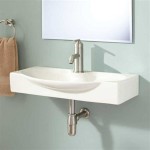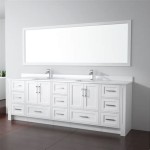What Is The Ideal Height For A Bathroom Vanity Sink Unit?
Determining the ideal height for a bathroom vanity sink unit is a crucial aspect of bathroom design, impacting both functionality and comfort. A well-chosen height can significantly improve the user experience, while an inappropriate height can lead to discomfort, strain, and long-term ergonomic issues. The selection process necessitates a careful consideration of various factors, including building codes, user needs, plumbing regulations, and aesthetic preferences. This detailed examination highlights the key elements involved in establishing the optimal vanity height.
The bathroom vanity has evolved beyond a simple sink base to become a focal point of bathroom design. Vanity units offer storage solutions, counter space, and an aesthetic contribution to the overall ambiance of the bathroom. The height of this unit plays a significant role in determining its usability, affecting everything from daily hygiene routines to the overall flow of the bathroom space. Therefore, carefully considering the height of the vanity is essential for achieving a practical and visually appealing bathroom.
Standard bathroom vanity heights have been established over time to accommodate the average adult user. However, considering individual requirements and varying needs within a household is critical. The standard height provides a baseline, but modifications may be necessary to ensure comfort and accessibility for all users.
Understanding Standard Vanity Heights
The conventional standard height for bathroom vanity sink units typically falls within the range of 30 to 36 inches (76 to 91 cm). This measurement refers to the distance from the floor to the top of the vanity countertop. The rationale behind this standardized range stems from observations and studies aimed at accommodating the average adult's standing height for common bathroom tasks such as washing hands, brushing teeth, and applying makeup.
The lower end of the standard range, approximately 30 to 32 inches, was initially the prevalent standard. However, over time, a taller vanity height, often around 36 inches, has gained popularity. This shift is attributed to ergonomic considerations, aiming to reduce back strain and improve posture during prolonged use. The taller height allows users to stand more upright, lessening the need to bend or stoop repeatedly, thereby minimizing discomfort.
While the standard height offers a widely applicable baseline, it's important to acknowledge that the "average" user is a statistical representation and may not accurately reflect the specific needs of all individuals or households. Differences in height, age, physical abilities, and personal preferences can influence the optimal vanity height for a particular user. Therefore, while adhering to the standard height can be a convenient starting point, customization should be considered to cater to individual requirements and ensure optimal comfort and functionality.
Factors Influencing the Ideal Vanity Height
Numerous factors should be taken into account when determining the ideal height for a bathroom vanity, going beyond general standards. These factors ensure that the selected height aligns with the practical and aesthetic needs of the users and the overall bathroom design.
User height and physical abilities constitute a primary consideration. Individuals who are significantly taller or shorter than average may find the standard vanity height uncomfortable. For taller individuals, a higher vanity can alleviate back strain, while shorter individuals may require a lower vanity for comfortable reach. Similarly, individuals with mobility issues or disabilities may benefit from customized vanity heights that accommodate wheelchairs or other assistive devices. The Americans with Disabilities Act (ADA) provides guidelines for accessible design, specifying a maximum vanity height of 34 inches for accessible bathrooms.
The type of sink to be installed also impacts the overall vanity height. Different sink styles, such as vessel sinks, undermount sinks, and drop-in sinks, have varying heights that need to be factored into the overall calculation. Vessel sinks, which sit on top of the countertop, will effectively increase the overall height of the vanity. Undermount sinks, which are installed beneath the countertop, typically require a thicker countertop material, slightly reducing the available height below the sink. Drop-in sinks, also known as self-rimming sinks, sit partially within a cutout in the countertop, with the rim resting on the countertop surface. It is essential to consider the dimensions of the selected sink to ensure the final installation meets the desired ergonomic and aesthetic requirements.
The intended use of the bathroom also plays a significant role. In a master bathroom, where adults primarily use the vanity, the standard height of 36 inches is often suitable. In a children's bathroom or a guest bathroom used by individuals of varying heights, a lower vanity height or a combination of heights may be more appropriate. Dual vanities can be installed at different heights to accommodate the needs of multiple users with varying heights. In addition, the activities performed at the vanity, such as applying makeup or shaving, can influence the ideal height. For instance, individuals who frequently apply makeup at the vanity may prefer a seated vanity with a customized height that allows for comfortable posture and optimal viewing in the mirror.
Customization and Alternatives to Standard Heights
When the standard vanity height does not meet the specific needs of the users or the design requirements of the bathroom, customization and alternative solutions become necessary. Several options are available to ensure that the vanity height aligns with the individual preferences and practical requirements of the space.
Adjustable-height vanities provide a flexible solution for households with multiple users of varying heights or individuals who require a vanity that can be easily modified over time. These vanities are designed with a mechanism that allows the height to be adjusted within a certain range, accommodating different users and activities. The adjustment mechanism can be manual or motorized, providing ease of use and convenience. Adjustable-height vanities are particularly useful in bathrooms shared by children and adults or in households where individuals have changing physical needs.
Wall-mounted vanities offer another alternative to standard vanity heights. These vanities are mounted directly to the wall, allowing the height to be customized to suit the specific needs of the users. Wall-mounted vanities also create a sense of spaciousness in the bathroom, as they do not extend to the floor, providing more visible floor space. The installation of wall-mounted vanities requires careful consideration of the wall structure and plumbing connections to ensure stability and proper drainage. However, the flexibility in height customization and the aesthetic appeal make them a popular choice in modern bathroom designs.
For households with young children, installing a step stool or platform near the vanity can provide a temporary solution for reaching the sink and countertop. This option is particularly useful when a full vanity replacement is not feasible or when the children's growth necessitates ongoing adjustments. A well-designed step stool or platform should be stable and secure to prevent accidents and should be easily accessible for children to use. The step stool can be integrated into the bathroom décor to blend seamlessly with the overall design.
In summary, the ideal height for a bathroom vanity sink unit is contingent upon a variety of factors, including standard guidelines, user preferences, sink type, and design considerations. While the standard heights offer practical starting points, customization and alternatives might be necessary to accommodate individual needs and preferences. A well-considered vanity height enhances both the functionality and aesthetic appeal of the bathroom, ensuring a comfortable and efficient user experience.

What Is The Standard Bathroom Vanity Height Size Guide

What Is The Standard Bathroom Vanity Height Size Guide

How To Choose Your Bathroom Vanity Height

How To Choose The Right Vanity For Your Bathroom Riverbend Home

Explore The Best Standard Vanity Height Options

Bathroom Vanities Buy Vanity Furniture Cabinets Rgm Distribution
/basement%20reno/Vanity%202.jpg?strip=all)
How To Choose Your Bathroom Vanity Height

What Is The Standard Height Of A Bathroom Vanity Sizes Vessel Sink Small Sinks

How To Choose The Perfect Bathroom Vanity Height Family Handyman

How To Choose Your Bathroom Vanity Height
Related Posts







